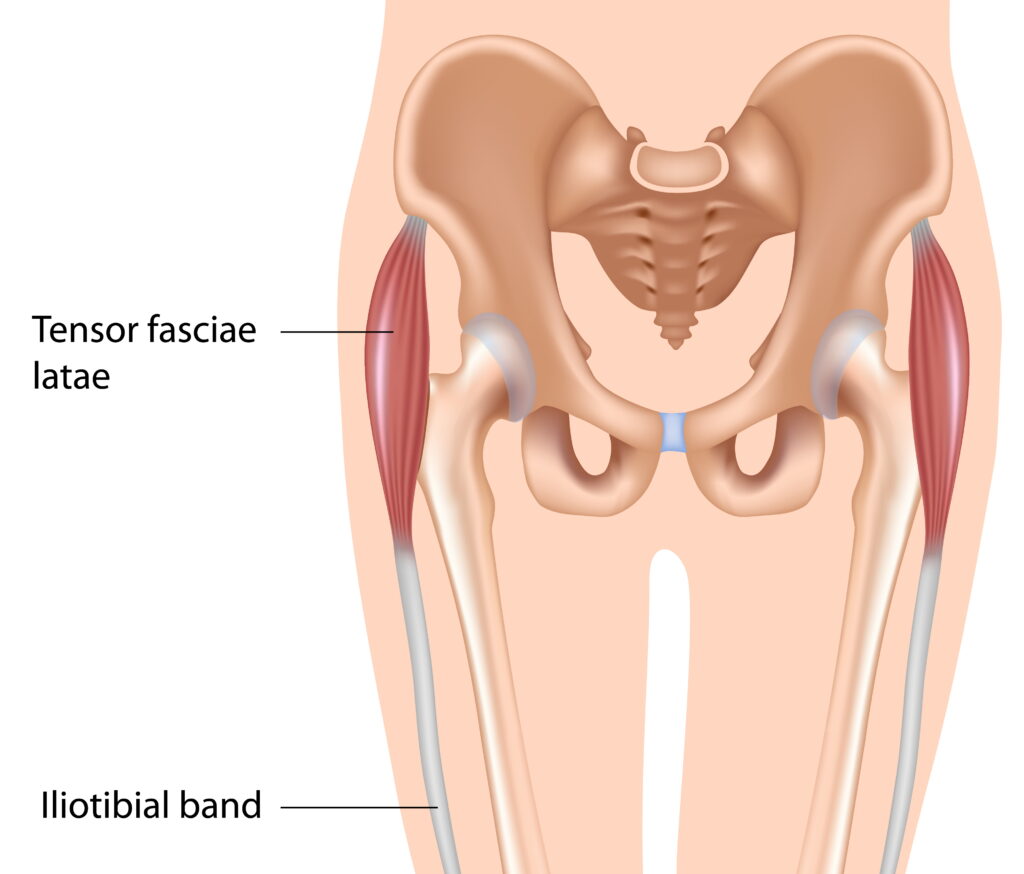Hip pain is a common injury in active runners. Pain outside the hip is thought to be due to trochanteric bursitis or gluteus medius tendinopathy. However, an injury to the TFL or tensor fasciae latae is also reasonably common in runners. This condition is called TFL pain or proximal ITB syndrome. So what is tensor fasciae latae pain, and how do we treat it?
TFL anatomy

The TFL muscle starts at the front of the pelvis, also known as the iliac crest. It covers the outside of the hip joint and forms into the iliotibial band.
It is vital to support the hip during walking and running with the ITB. In excessive running, there is an overload of the TFL leading to swelling of the attachment – also called enthesopathy. Also, we think that weakness in the other muscles of the pelvis (such as the glutes or hip flexor) leads to more load on the TFL muscle.
Clinical diagnosis of tensor fasciae latae pain

Usually, people report pain on the outside of the hip. However, the tensor fasciae latae pain is usually slightly higher than the more common trochanteric bursitis. Hip pain generally occurs during running and can last a few days before settling. Most people report pain close to the iliac crest with some radiation to the outer part of the hip.
Generally, there is pinpoint tenderness at the iliac crest when examining a runner. Sometimes, pain is reproduced with hip tests such as resisted hip abduction.
It is essential to rule out other causes of outer hip pain, including greater trochanteric syndrome, hip arthritis, hip stress fracture, and nerve damage.
Imaging is often helpful in confirming the diagnosis of TFL pain. This is because ultrasound will show localised thickening and swelling of the TFL attachment to the bone. MRI will also show changes. However, an MRI scan might sometimes miss the TFL thickening if the correct slices are not performed. Generally, the TFL attachment is thickened if greater than 4mm.

Tensor fasciae latae pain treatment
Overall, the treatment of TFL pain mirrors the general treatment of tendinopathy.
Firstly, we recommend you reduce or avoid those activities that aggravate your hip pain. Generally, these activities include hiking and running. Next, you can cross-train with cycling and swimming to maintain fitness. Finally, you can incorporate a progressive running program to keep pain levels low as the pain improves.
TFL exercises
In most cases, TFL enthesopathy is related to weakness in the pelvis muscles. Therefore, you should work closely with a therapist to strengthen any weaknesses. Examples of exercises include hamstring bridges, crab walks with a band, and step-ups. Generally, we recommend exercises every 2-3 days.
Other treatments for tensor fasciae latae pain
Sometimes, TFL pain continues despite a prolonged period of modified activity and exercise. We add treatments to help but not harm the tendon in these cases. Overall, we suggest non-invasive treatments first as risks are lower.
GTN patch for tendonitis
GTN patches contain nitric oxide. We know that nitric oxide is essential in tendon healing. By placing the patch onto the skin over the swollen TFL tendon, nitric oxide is transferred to the tendon.
Recent evidence suggests that nitric oxide patches improve the pain of tendinopathy. Generally, we recommend you use these patches for 2-3 months.
Shockwave therapy
We think that TFL pain responds to shockwave therapy more than other tendons. Therefore, we suggest five sessions spaced over five weeks (i session per week) in conjunction with exercise.
Injections for tensor fasciae latae pain
Overall, injection therapy is more invasive and less predictable than other treatments. However, we occasionally use injections for TFL pain that has failed other treatments.
Our first-line injection treatment is low-dose cortisone. Then, using ultrasound, we direct the cortisone just above and below the area of thickening. In this way, the injection is more effective with fewer side effects. Some common side effects of a TFL injection are skin atrophy and depigmentation. Generally, using ultrasound reduces the chances of these cortisone side effects.
Other injection options include needle tenotomy or PRP. However, there is no evidence that these injections work in TFL pain. You should avoid NSAIDs for at least two weeks after needle tenotomy or PRP. If you’ve had a cortisone injection, you should wait at least a month before proceeding with needle tenotomy or PRP injection.
Final word from Sportdoctorlondon on tensor fasciae latae pain
Tensor fasciae latae pain is a common cause of pain outside the hip. It is often misdiagnosed as a greater trochanteric syndrome. A correct diagnosis will allow early and effective treatment and enable you to return to running and sports faster.



Leave A Comment